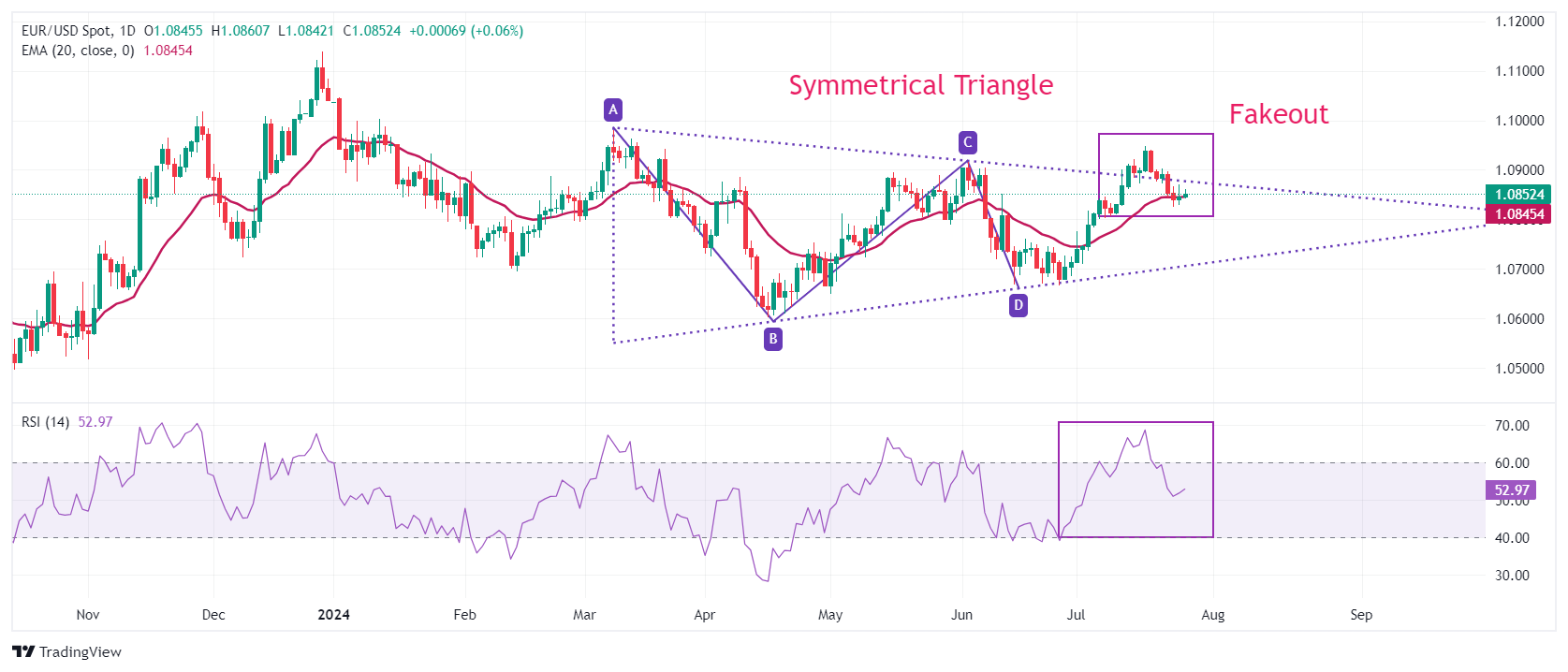EUR/USD trades sideways in countdown to US core PCE inflation
- EUR/USD shifts to the sidelines with the US core PCE Price Index for June in focus.
- Annual US core PCE inflation is estimated to have decelerated to 2.5%.
- The Euro remains on the backfoot due to multiple headwinds.
EUR/USD consolidates above a two-week low of 1.0825 in Friday’s European session. The major currency pair trades in a tight range, with investors focussing on the United States (US) core Personal Consumption Expenditures price index (PCE) data for June, which will be published at 12:30 GMT.
Economists expect that the underlying inflation decelerated to 2.5% year-over-year in June from the prior release of 2.6%, with the monthly figure growing steadily by 0.1%. The inflation report will significantly influence market expectations for Federal Reserve (Fed) rate cuts this year. Financial market participants currently see the speculation for interest rate cuts in September as certain. Softer-than-expected inflation figures would strengthen expectations for September rate cuts, while stubborn figures would diminish them.
Meanwhile, the US Dollar exhibits a subdued performance as investors have been sidelined, knowing that the underlying inflation would significantly impact the outlook on interest rates by the Fed in its monetary policy announcement on Wednesday. The Fed is expected to leave its key borrowing rates unchanged in the range of 5.25%-5.50% in the July 31 meeting.
Daily digest market movers: EUR/USD consolidates while Euro’s outlook remains uncertain
- EUR/USD holds key support of 1.0825 even though investors worry about the Euro’s outlook due to multiple headwinds. The Eurozone’s economic prospects have been battered significantly, as its largest nation is going through a rough phase. Flash German Hamburg Commercial Bank (HCOB) Composite Purchasing Managers Index (PMI) contracted in July due to a decline in private sector business activity. The PMI data came in lower at 48.7 from the prior release of 50.4.
- Commenting on the flash PMI data, Dr. Cyrus de la Rubia, Chief Economist at HCOB, said, "This looks like a serious problem. Germany’s economy fell back into contraction territory, dragged down by a steep and dramatic fall in manufacturing output. The hope that this sector could benefit from a better global economic climate is vanishing into thin air. With the composite PMI now below 50, our GDP Nowcast predicts that economic output will shrink by 0.4% in the third quarter compared to the second quarter. While it is still early days and many data points are yet to come, the second half of the year is starting on a very weak note.”
- Meanwhile, rising expectations of two more rate cuts by the European Central Bank (ECB) have also weighed down the Euro. A few ECB policymakers see firm speculation for two more rate cuts as appropriate. The confidence of ECB policymakers has increased amid expectations that inflation will sustainably return to the desired rate of 2% in 2025. Also, rate cuts are needed for the economy’s revival. The announcement of tax relief of 30 billion euros by German Finance Minister Christian Lindner for corporations and households on Wednesday has indicated the government’s concerns over a poor demand environment.
- Going forward, the major trigger for the Euro will be preliminary Eurozone Harmonized Index of Consumer Prices (HICP) data for July, which is scheduled for next week. The inflation data will provide fresh cues about when the ECB will cut interest rates again. Currently, traders expect the ECB to resume its policy-easing cycle in September.
Technical Analysis: EUR/USD hovers above 1.0800

EUR/USD trades inside Thursday’s trading range ahead of US core PCE inflation data for June. The shared currency pair remains inside the Symmetrical Triangle pattern on a daily timeframe after failing to hold the breakout. The major currency pair extends its downside below the 20-day Exponential Moving Average (EMA), which trades around 1.0840, and could slide further towards round-level supports near 1.0800 and 1.0700.
The 14-day Relative Strength Index (RSI) returns within the 40.00-60.00 range, suggesting the bullish momentum has faded.
On the upside, the round-level resistance of 1.0900 will be a key barrier for the Euro bulls.
Euro FAQs
The Euro is the currency for the 20 European Union countries that belong to the Eurozone. It is the second most heavily traded currency in the world behind the US Dollar. In 2022, it accounted for 31% of all foreign exchange transactions, with an average daily turnover of over $2.2 trillion a day. EUR/USD is the most heavily traded currency pair in the world, accounting for an estimated 30% off all transactions, followed by EUR/JPY (4%), EUR/GBP (3%) and EUR/AUD (2%).
The European Central Bank (ECB) in Frankfurt, Germany, is the reserve bank for the Eurozone. The ECB sets interest rates and manages monetary policy. The ECB’s primary mandate is to maintain price stability, which means either controlling inflation or stimulating growth. Its primary tool is the raising or lowering of interest rates. Relatively high interest rates – or the expectation of higher rates – will usually benefit the Euro and vice versa. The ECB Governing Council makes monetary policy decisions at meetings held eight times a year. Decisions are made by heads of the Eurozone national banks and six permanent members, including the President of the ECB, Christine Lagarde.
Eurozone inflation data, measured by the Harmonized Index of Consumer Prices (HICP), is an important econometric for the Euro. If inflation rises more than expected, especially if above the ECB’s 2% target, it obliges the ECB to raise interest rates to bring it back under control. Relatively high interest rates compared to its counterparts will usually benefit the Euro, as it makes the region more attractive as a place for global investors to park their money.
Data releases gauge the health of the economy and can impact on the Euro. Indicators such as GDP, Manufacturing and Services PMIs, employment, and consumer sentiment surveys can all influence the direction of the single currency. A strong economy is good for the Euro. Not only does it attract more foreign investment but it may encourage the ECB to put up interest rates, which will directly strengthen the Euro. Otherwise, if economic data is weak, the Euro is likely to fall. Economic data for the four largest economies in the euro area (Germany, France, Italy and Spain) are especially significant, as they account for 75% of the Eurozone’s economy.
Another significant data release for the Euro is the Trade Balance. This indicator measures the difference between what a country earns from its exports and what it spends on imports over a given period. If a country produces highly sought after exports then its currency will gain in value purely from the extra demand created from foreign buyers seeking to purchase these goods. Therefore, a positive net Trade Balance strengthens a currency and vice versa for a negative balance.

